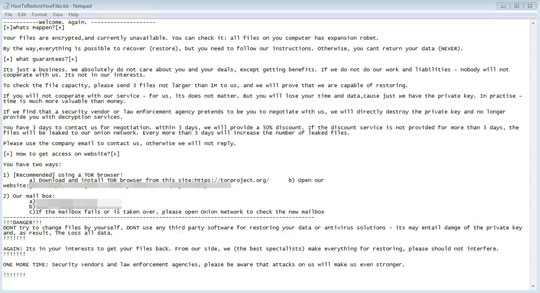Ransom.Win64.ROOK.YXCAC
Ransom:Win32/RookCrypt.PA!MTB (MICROSOFT); Win64/Filecoder.Rook.A trojan (NOD32)
Windows


Threat Type: Ransomware
Destructiveness: No
Encrypted: Yes
In the wild: Yes
OVERVIEW
Downloaded from the Internet
This Ransomware arrives on a system as a file dropped by other malware or as a file downloaded unknowingly by users when visiting malicious sites.
It executes then deletes itself afterward.
It drops files as ransom note. It avoids encrypting files with the following file extensions.
TECHNICAL DETAILS
174,080 bytes
EXE
Yes
31 Dec 2021
Displays message/message boxes, Encrypts files, Disables services, Terminates processes
Arrival Details
This Ransomware arrives on a system as a file dropped by other malware or as a file downloaded unknowingly by users when visiting malicious sites.
Installation
This Ransomware adds the following processes:
- cmd.exe /c vssadmin.exe delete shadows /all /quiet
It executes then deletes itself afterward.
It adds the following mutexes to ensure that only one of its copies runs at any one time:
- asfgjkl878645165456fa888
Other System Modifications
This Ransomware adds the following registry entries as part of its installation routine:
HKEY_CURRENT_USER\Software
RookPrivateKey = {Hex Values}
HKEY_CURRENT_USER\Software
RookPublicKey = {Hex Values}
Process Termination
This Ransomware terminates the following services if found on the affected system:
- AcronisAgent
- AcrSch2Svc
- backup
- CAARCUpdateSvc
- CASAD2DWebSvc
- ccEvtMgr
- ccSetMgr
- DefWatch
- GxBlr
- GxCIMgr
- GxCVD
- GxFWD
- GxVss
- Intuit.QuickBooks.FCS
- memtas
- mepocs
- QBCFMonitorService
- QBFCService
- QBIDPService
- RTVscan
- SavRoam
- sql
- svc$
- veeam
- vss
It terminates the following processes if found running in the affected system's memory:
- agntsvc.exe
- dbeng50.exe
- dbsnmp.exe
- encsvc.exe
- excel.exe
- firefox.exe
- infopath.exe
- isqlplussvc.exe
- msaccess.exe
- mspub.exe
- mydesktopqos.exe
- mydesktopservice.exe
- notepad.exe
- ocautoupds.exe
- ocomm.exe
- ocssd.exe
- onenote.exe
- oracle.exe
- outlook.exe
- powerpnt.exe
- sqbcoreservice.exe
- sql.exe
- steam.exe
- synctime.exe
- tbirdconfig.exe
- thebat.exe
- thunderbird.exe
- visio.exe
- winword.exe
- wordpad.exe
- xfssvccon.exe
Other Details
This Ransomware does the following:
- It empties the Recycle Bin.
- It encrypts files from the local drives and network shares.
- It uses Windows Restart Manager to unlock files it will encrypt.
- It renames the malware to "{Malware Name}:ask" during execution.
It accepts the following parameters:
- -debug {log file name} - for logging
- -shares {network shares to encrypt} - encrypt specified network shares
- -paths {drives to encrypt} - encrypt specified drives
Ransomware Routine
This Ransomware avoids encrypting files with the following strings in their file path:
- #recycle
- $Recycle Bin
- All Users
- AppData
- autorun.inf
- Boot
- boot.ini
- bootfont.bin
- bootmgfw.efi
- bootmgr
- bootmgr.efi
- bootsect.bak
- desktop.ini
- iconcache.db
- Internet Explorer
- Mozilla
- Mozilla Firefox
- ntldr
- ntuser.dat
- ntuser.dat.log
- ntuser.ini.
- Opera
- Opera Software
- Program Files
- Program Files (x86)
- ProgramData
- thumbs.db
- Tor Browser
- Windows
- Windows.old
- HowToRestoreYourFiles.txt
- {Log file name}
It appends the following extension to the file name of the encrypted files:
- .Rook
It drops the following file(s) as ransom note:
- {Encrypted Directory}\HowToRestoreYourFiles.txt

It avoids encrypting files with the following file extensions:
- .exe
- .dll
- .Rook
SOLUTION
9.800
17.292.04
03 Jan 2022
17.293.00
04 Jan 2022
Step 1
Trend Micro Predictive Machine Learning detects and blocks malware at the first sign of its existence, before it executes on your system. When enabled, your Trend Micro product detects this malware under the following machine learning name:
-
Troj.Win32.TRX.XXPE50FFF051
Step 2
Before doing any scans, Windows 7, Windows 8, Windows 8.1, and Windows 10 users must disable System Restore to allow full scanning of their computers.
Step 3
Note that not all files, folders, and registry keys and entries are installed on your computer during this malware's/spyware's/grayware's execution. This may be due to incomplete installation or other operating system conditions. If you do not find the same files/folders/registry information, please proceed to the next step.
Step 4
Restart in Safe Mode
Step 5
Delete these registry values
Important: Editing the Windows Registry incorrectly can lead to irreversible system malfunction. Please do this only if you know how to or you can seek your system administrator’s help. You may also check out this Microsoft article first before modifying your computer's registry.
- In HKEY_CURRENT_USER\Software
- RookPrivateKey = {Hex Values}
- RookPrivateKey = {Hex Values}
- In HKEY_CURRENT_USER\Software
- RookPublicKey = {Hex Values}
- RookPublicKey = {Hex Values}
Step 6
Search and delete these files
- {Encrypted Directory}\HowToRestoreYourFiles.txt
Step 7
Restart in normal mode and scan your computer with your Trend Micro product for files detected as Ransom.Win64.ROOK.YXCAC. If the detected files have already been cleaned, deleted, or quarantined by your Trend Micro product, no further step is required. You may opt to simply delete the quarantined files. Please check this Knowledge Base page for more information.
Step 8
Restore encrypted files from backup.
Did this description help? Tell us how we did.

